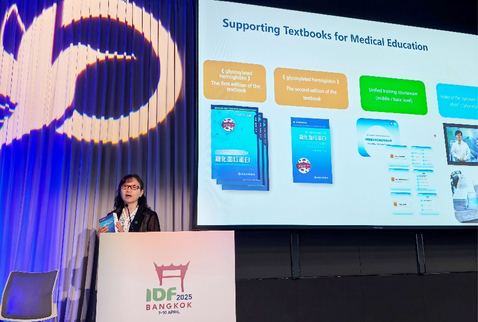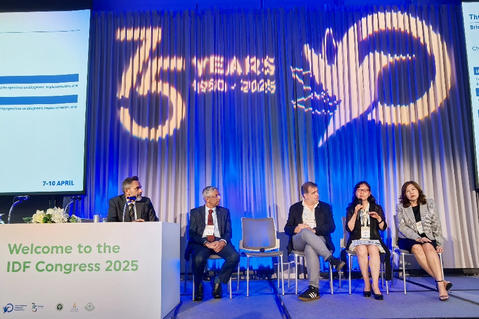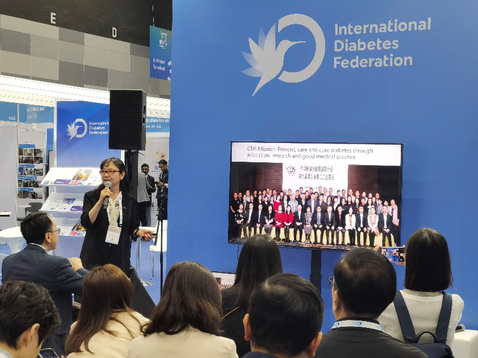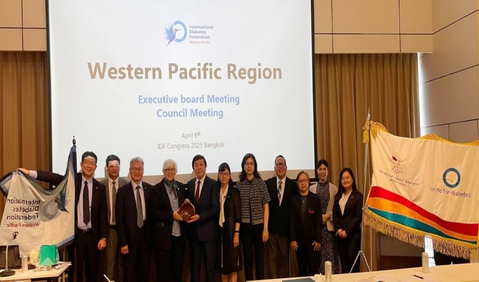On the occasion of the 75th anniversary of the founding of the International Diabetes Federation (IDF), the IDF2025 World Diabetes Conference was held in Bangkok, Thailand from April 7 to 10, 2025. On the occasion of the 75th anniversary of the founding of the International Diabetes Federation (IDF), the IDF2025 World Diabetes Conference was held in Bangkok, Thailand from April 7 to 10, 2025. With the theme of "Shape the future of diabetes", the conference gathered experts and scholars in the field of diabetes around the world to conduct in-depth discussions on the core topic of diabetes. With the theme of "Shape the future of diabetes", the conference gathered experts and scholars in the field of diabetes around the world to conduct in-depth discussions on the core topic of diabetes.
During the conference, Professor Chen Liming from Tianjin Medical University Chu Hsien-I Memorial Hospital was invited to attend the special session of "HbA1c Global perspective: a bridge to diabetes management" to give a report and participate in the expert group discussion. On behalf of the Chinese Medical Diabetes Society (CDS), the author appeared on the international stage and introduced the history of CDS, the update and promotion of Chinese diabetes prevention and treatment guidelines, the research work of Chinese scholars and the progress of international cooperation projects with the topic of "CDS in Diabetes Care". Before the meeting, the replacement meeting of the Executive Committee of the International Diabetes Federation-Western Pacific Region (IDF-WPR) was held, and Professor Chen Liming was reelected as the executive committee of IDF-WPR by high vote.
In the meeting on April 10th, Professor Chen systematically introduced the progress of the CGHSP with the title of "HbA1c from a national perspective: China Glycated Hemoglobin Standardization Project (CGHSP)". This project has greatly promoted the process of HbA1c measurement standardization in China. In 2020, CDS officially included HbA1c as a diagnostic criterion in the Chinese Guidelines for the prevention and treatment of type 2 diabetes (2020 Edition). The number of laboratories participating in EQA increased from 23 in 2000 to 4,651 in 2024, and the CV decreased from 16.4 to 2.89.
In the fifth phase (2025-2027) of the "China Glycated Hemoglobin A1c Standardization Plan", the China Diabetes Goal Attainment Center, China Glycated hemoglobin Standardization Center and network will be established nationwide to promote the precision of Hba1c measurement and standardization of diagnosis and treatment. During the past 16 years, this project has attracted the attention of the government, medical associations, clinical doctors, and laboratory professionals. It has carried out physician training and popular science education in more than 400 cities, invited more than 2,300 experts to give lectures, and trained more than 150,000 medical workers, playing a positive role in the prevention and treatment of diabetes in "Healthy China".

Professor Chen Liming showed the training textbook of Glycated hemoglobin in China
Professor Viswanathan Mohan from India, Professor Joao Filipe Raposo from Portugal and Professor Apiradee Sriwijitkamol from Thailand then shared regional perspectives on HbA1c diagnosis and management in their countries. The conference Chair, Professor Rayaz Malik from Qatar, invited four speakers and delegates for a lively discussion on clinical concerns. Around HbA1c or CGM which can be used for diabetes diagnosis? If blood glucose and glycated hemoglobin are inconsistent, how to choose? With HbA1c testing, is CGM still necessary? Are the HbA1c cutoff values for the diagnosis of diabetes the same across regions? And the need to adjust HbA1c with hemoglobin measurement in patients with diabetes and anemia? The experts had an interactive discussion with the participants. Professor Chen Liming shared his work experience and believed that "HbA1c is suitable for the vast majority of the population, but for some special populations, such as anemia patients, HbA1c cannot reflect the true blood glucose level. Continuous glucose monitoring (CGM) can provide eHbA1c, which can more truly reflect the blood glucose level as an alternative index." "In clinical practice, there is a mismatch between fasting blood glucose and HbA1c, which may be due to the postprandial hyperglycemia in this patient. "Because of the high proportion of carbohydrate intake in Asian countries, it is necessary to check postprandial blood glucose. We recommend that patients reduce the proportion of staple foods, reduce postprandial hyperglycemia, and further improve glycosylated hemoglobin levels." At the same time, the optimal cut-off value of HbA1c for the diagnosis of diabetes in China was introduced.

Professor Rayaz Malik(Chair), had a lively discussion with the speakers, Professor Viswanathan Mohan, Professor Joao Filipe Raposo, Professor Liming Chen and Professor Apiradee Sriwijitkamol
Representing CDS on the international stage
On April 9th, Professor Chen Liming, on behalf of CDS, gave a speech entitled "CDS in Diabetes Care" at IDF Exhibition area of International Trade and Exhibition Center in Bangkok, Thailand. She introduced the history of CDS. The Chinese Diabetes Society (CDS) was established in October 1991 in Shanghai, its predecessor was the Diabetes Group of the Chinese Medical Association Endocrine Society. As early as 1987, the Diabetes Group joined the International Diabetes Federation under the name of "Diabetes Society of Chinese Medical Association". In 2002, China successfully hosted the 5th International Diabetes Federation-Western Pacific (IDF-WPR) Conference for the first time.
The prevalence of T2DM in China is still increasing year by year and showing a younger trend. China is the country with the largest number of diabetic patients. According to the data of IDF Diabetes Map (11 edition), the number of diabetic patients in China is up to 148 million. CDS has updated the diabetes prevention and treatment guidelines for seven times. Through the theme of "Blue Light Action", CDS has lit up nearly 70 landmark blue light buildings around the country, and carried out various forms of activities such as free screening and diagnosis, popular science lectures and media publicity.
Then, Professor Chen Liming introduced the representative research results published by Chinese experts in the past three years, involving epidemiology, dietary patterns, diabetic complications, islet transplantation and AI-enabled diabetes management.
CDS-ADA International Academic Exchange Program (iACP) was officially launched at the 2019 ADA Annual Meeting. The Metabolic Disease Hospital of Tianjin Medical University was one of the first participating units to communicate with Professor Jennifer Green of Duke University and Professor Sylvia E. Rosas of Joslin Diabetes Center of Harvard University in the United States. The program lasted for three years, and a total of 18 online and offline exchanges were held, benefiting about 500 Chinese and American diabetes medical staff.

Professor Chen Liming introduced the mission of CDS
Elected member of IDF-WPR Executive Committee
The IDF-WPR is composed of 28 academic organizations from 21 countries in East Asia, South Asia and Oceania, and is the region with the largest population and the largest number of diabetic patients in the International Diabetes Federation. The nine members of the IDF-WPR Executive Board are elected by the 28 member societies of the IDF-WPR. In this council meeting, academician-Jia Weiping became the president-elect of IDF-WPR after nomination and competitive election, and Professor Chen Liming was re-elected as the new executive committee member of IDF-WPR.

Executive committee members of IDF-WPR